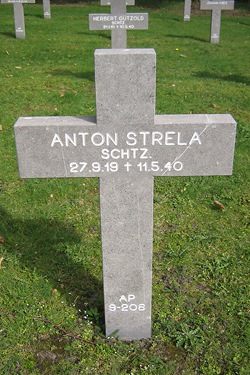
Anton Strela
Notities
- IR.481 leidde de aanval op het wegenknooppunt Mill, een sleutelpositie in de Peel-Raamstelling. III./IR.481 was aan boord van de gepantserde goederentrein die achter de Panzerzug door de stelling reed en nabij halte Zeeland ontlaadde. De overige twee bataljons werden als eerste bij Gennep over de Maas gebracht via de veroverde spoorbrug en stootten door naar het dorpje Mill. Zij kwamen vanaf de middag van 10 mei 1940 in gevecht met de vasthoudende Nederlandse defensie bij Mill. Pas laat in de middag kwam IR.456 ter ondersteuning in de sector aan. Gezamelijk werd de avondaanval ingezet, die uiteindelijk mede wegens een zwaar luchtbombardement leidde tot de Duitse doorbraak van de Peel-Raamstelling in de sector Mill - Langenboom - Zeeland. De exacte Duitse verliescijfers vari ren sterk per bron.
- III./IR.481 was het treinbataljon. Na te zijn uitgeladen achter de stelling bij Mill, trad 11.Kp noord van het spoor en 10.Kp zuid van het spoor op. 9.Kp bleef bij het spoor in reserve. 12.Kp was verdeeld over alle drie de tirailleurcompagnie n. 11.Kp werd door de artilleristen van III-20.RA afgewezen en voerde nadien gevechten in de bossen, terwijl 10.Kp een aantal kazematten wist te veroveren zuid van het spoor. In die laatste positie concentreerde later zich het gehele bataljon en voerde het nog enige vuurgevechten met de verdediging en 2.RHM dat vanuit het westen tegen de Duitse penetratie was ingezet. Pas laat in de avond werd het bataljon door haar eigen regiment ontzet. Het had nauwelijks kunnen bijdragen aan de gevechten en was opvallend passief gebleven.
- Volgens EH Brongers was de naam 'Strela', was hij van 6./IR.481 en sneuvelde hij op 11 mei te Mill. EKM en Ysselsteyn register (niet graf) geven aan 'Strehla', 10./IR.481 en sneuvelen oo 10 mei 1940.
- IR.481 formed the most forward element of 256.ID during the offensive against the main Dutch defence-line (Peel-Raam) at the village Mill, that formed a strategic infrastructural point in the area. The German battalion III./IR.481 was on board of the armoured personnel train that followed the armoured train (Panzerzug no.1) when both Maas- and Peel-Raamline were penetrated by these trains in the early morning of May 10, 1940. The battalion was offloaded about two km behind the Dutch defence-line at Mill, and soon developed against the Dutch positions near the canal and railway line. The other two battalions of the regiment followed later, the traditional way, after crossing the intact Gennep bridge across the Maas. They arrived near Mill around noon. Only late in the afternoon the second regiment, IR.456, joint the already fully engaged IR.481 in battle. After an extensive Luftwaffe raid on the Dutch defences just before dawn, both regiments engaged the Dutch defences in a full scale offensive manoeuvre and eventually managed to push the Dutch aside and breach the main defences in the triangle Mill - Langenboom - Zeeland. It wasn't until 11 May in the late morning before all resistance had been cleared. The exact total number of German casualties is unclear, due to conflicting evidence.
- III./IR.481 was the 'train-battalion' that had been successfully offloaded behind the Dutch main defences at Mill in the early morning. After evacuating the train 11.Kp operated north of the railway track, 10.Kp south. 9.Kp was held in reserve in the centre, whereas 12.Kp had been divided over the three other companies. 11.Kp was denied access to the Dutch defence by an artillery unit (III-20.RA) and moved into the forest where it fought some fierce battles. 10.Kp was denied access to the road south of the railway-track but managed to conquer about a dozen Dutch pill-boxes south of the track by assaulting those from the blind rear side. It was at that very location that later the entire German battalion would reassemble and built a firm defence. Although it hardly contributed to the success of the German offensive at Mill, it did manage to rebuff Dutch attempts to force them out and was relieved by its own regiment in the late evening.
- There are indications that Strehla should read Strela and that subject soldier was KIA on 11 May 1940 as member of 6./IR.481. The EKM and grave registry (not grave itself) indicate however the more logical details shown hereabove.
Beeldmateriaal
- Geen.
Relevante links
- Geen.
